文件
1、什么是文件?
文件是我们保存数据的地方。
2、文件流
文件在程序中是以流的形式来操作的。
流:数据在数据源(文件)和程序(内存)之间经历的路径
输入流:数据从数据源(文件)到程序(内存)的路径
输出流:数据从程序(内存)到数据源(文件)的路径
3、常用的文件操作
1、创建文件对象相关构造器和方法
new File(String pathname) //根据路径构建一个File对象
new File(File parent,String child) //根据父目录文件+子路径构建
new File(String parent,String child) //根据父目录+子路径构建
createNewFile() //创建文件
import org.testng.annotations.Test;
import java.io.File;
import java.io.IOException;
public class FileCreate {
public static void main(String[] args) {
}
//方式1
1 @Test 2 3 public void create1(){ 4 5 String filePath = "D:\\file1.txt"; 6 7 File file = new File(filePath); 8 9 10 11 try { 12 13 file.createNewFile(); 14 15 System.out.println("创建文件1成功"); 16 17 } catch (IOException e) { 18 19 e.printStackTrace(); 20 21 } 22 23 24 25 }
结果:

//方式2
1 @Test 2 public void create2(){ 3 4 File parentFile = new File("D:\\"); 5 6 String fileNane = "file2.txt"; 7 8 File file = new File(parentFile, fileNane); 9 10 11 12 try { 13 14 file.createNewFile(); 15 16 System.out.println("文件2创建成功"); 17 18 } catch (IOException e) { 19 20 throw new RuntimeException(e); 21 22 } 23 24 25 26 }
结果:
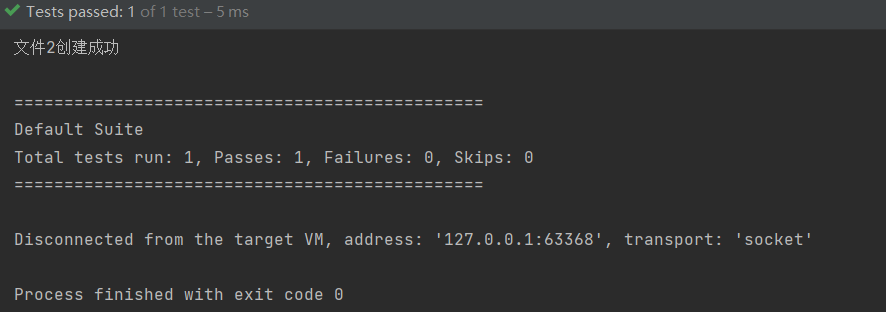
//方式三
1 @Test 2 public void create3(){ 3 4 String parentPath = "d:\\"; 5 6 String filePath = "file3.txt"; 7 8 File file = new File(parentPath, filePath); 9 10 try { 11 file.createNewFile(); 12 System.out.println("文件3创建成功"); 13 } catch (IOException e) { 14 throw new RuntimeException(e); 15 } 16 17 }
结果:
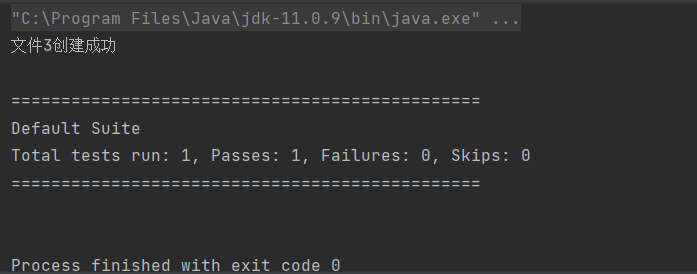
2、获取文件的相关信息
常见的File相关方法
getName()/getAbsolutePath/getParent/length/exists/isFile/isDirectory
获取文件名、获取绝对路径
UTF-8一个英文一个字节,一个汉字三个字节
import org.testng.annotations.Test;
import java.io.File;
public class FileInformation {
public static void main(String[] args) {
}
//获取文件信息
1 @Test 2 public void Info(){ 3 //先创建文件对象 4 File file = new File("D:\\file1.txt"); 5 //调用相应方法,得到对应信息 6 System.out.println("文件名称:"+file.getName()); 7 8 System.out.println("文件绝对路径:"+file.getAbsolutePath()); 9 10 System.out.println("文件父目录:"+file.getParent()); 11 12 System.out.println("文件大小(字节):"+file.length()); 13 14 System.out.println("文件是否存在:"+file.exists()); 15 16 System.out.println("是否是文件:"+file.isFile()); 17 18 System.out.println("是否是目录:"+file.isDirectory()); 19 20 }
结果:
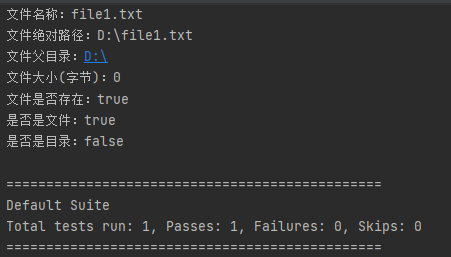
3、目录的操作
创建一级目录:mkdir,创建多级目录:mkdirs ,delete删除空目录或者文件
import org.testng.annotations.Test;
import java.io.*;
public class fileDirectory {
public static void main(String[] args) {
}
//删除文件
1 @Test 2 public void fileDelete(){ 3 4 String filePath = "D:\\file1.txt"; 5 6 File file = new File(filePath); 7 8 if(file.exists()){ 9 if(file.delete()){ 10 System.out.println(filePath+"删除成功"); 11 }else { 12 System.out.println(filePath+"删除失败"); 13 }; 14 }else{ 15 System.out.println("文件不存在"); 16 } 17 }
运行结果:
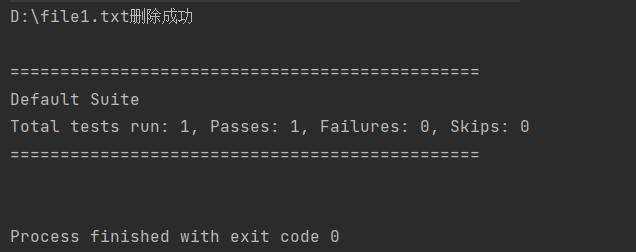
//删除目录
1 @Test 2 public void fileDeleteD(){ 3 4 String filePath = "D:\\file1.txt"; 5 6 File file = new File(filePath); 7 8 if(file.exists()){ 9 10 if(file.delete()){ 11 12 System.out.println(filePath+"删除成功"); 13 }else { 14 System.out.println(filePath+"删除失败"); 15 }; 16 17 }else{ 18 System.out.println("目录不存在"); 19 } 20 }
运行结果:
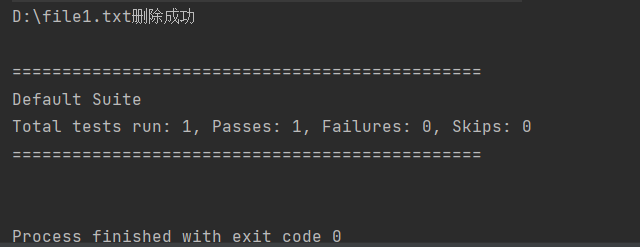
//判断目录是否存在,不存在就创建
1 @Test 2 public void fileDeleteD1(){ 3 4 String dirPath = "D:\\test\\dir1.txt"; 5 6 File file = new File(dirPath); 7 8 if(file.exists()){ 9 10 System.out.println(dirPath+"该目录已经存在"); 11 12 }else{ 13 14 if(file.mkdirs()){ 15 16 System.out.println("创建成功"); 17 18 }else { 19 20 System.out.println("创建失败"); 21 22 }; 23 24 } 25 26 }
运行结果:
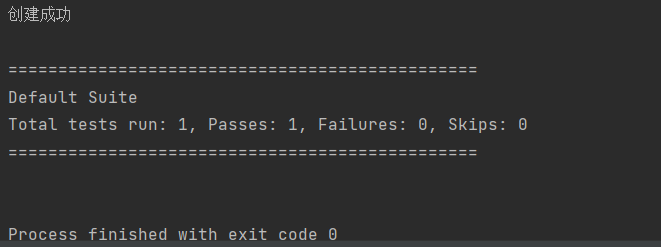
4、IO流原理及流的分类
1、I=input,O=output,用于处理数据传输,读写文件、网络通信
2、Java程序中,输入输出以流的形式进行
3、java.io包下
流的分类:
按操作数据单位不同可以分为:字节流(8bit)、字符流(字符,对应字节按照编码确定)
效率:字符流更好,字节流的存在是为了更好的处理二进制文件,音视频
按流向不同可以分为:输入流、输出流
按流的角色不同分为:节点流、处理流
public abstract class InputStream implements Closeable {
private static final int MAX_SKIP_BUFFER_SIZE = 2048;
public InputStream() {
}
public abstract int read() throws IOException;
public int read(byte[] var1) throws IOException {
return this.read(var1, 0, var1.length);
}
public abstract class OutputStream implements Closeable, Flushable {
public OutputStream() {
}
}
public abstract class Writer implements Appendable, Closeable, Flushable{
}
public abstract class Reader implements Readable, Closeable {
}
前面四个都是抽象类,想要使用必须实现其具体方法
5、Scanner与Println
1、基本键盘输入
import org.testng.annotations.Test;
import java.util.Scanner;
public class scanPrintTest {
public static void main(String[] args) {
//创建Scanner对象,接受从控制台输入
Scanner input = new Scanner(System.in);
//接受String类型
String str = input.next();
//输出结果
System.out.println(str);
System.out.println(“hello world”);
}
}
2、常见键盘输入类型
import java.util.Scanner;
public class scanTest {
public static void main(String[] args) {
Scanner input =new Scanner(System.in);
//double类型的数据
System.out.print(“请输入一个double类型的数:”);
double d = input.nextDouble();
System.out.println(d);
//int类型的数据
System.out.print(“请输入一个int类型的数:”);
int i = input.nextInt();
System.out.println(i);
//字符串类型的数据
System.out.print(“请输入一个string类型的数:”);
String s = input.next();
System.out.println(s);
}
}
6、InputStream
常见的子类
FileInputStream:文件输入流
BufferedStream:缓冲字节输入流
ObjectedStream:对象字节输入流
import org.testng.annotations.Test;
import java.io.FileInputStream;
import java.io.FileNotFoundException;
import java.io.IOException;
public class fileInputStream {
public static void main(String[] args) {
}
//1.读取文件
1 @Test 2 public void fileIn1(){ 3 String filePath = "D:\\testfile.txt"; 4 int readData; 5 FileInputStream fileInputStream = null; 6 try{ 7 //创建FileInputStream对象,用于读取文件 8 fileInputStream = new FileInputStream(filePath); 9 10 while ((readData = fileInputStream.read()) != -1){ 11 System.out.print((char)readData); 12 }; 13 14 }catch (IOException e){ 15 e.printStackTrace(); 16 }finally { 17 //关闭文件流 18 try { 19 fileInputStream.close(); 20 } catch (IOException e) { 21 throw new RuntimeException(e); 22 } 23 24 } 25 26 }
运行结果:
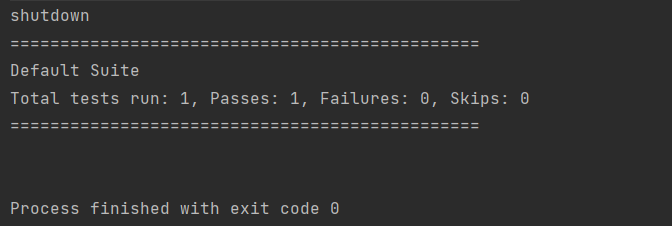
//2.读取文件
1 @Test 2 public void fileIn2(){ 3 String filePath = "D:\\testfile.txt"; 4 int readData; 5 int readlength = 0; 6 //字节数组 7 byte[] buf = new byte[8]; 8 FileInputStream fileInputStream = null; 9 try{ 10 //创建FileInputStream对象,用于读取文件 11 fileInputStream = new FileInputStream(filePath); 12 while ((readlength = fileInputStream.read(buf)) != -1){ 13 System.out.println(new String(buf,0,readlength)); 14 }; 15 }catch (IOException e){ 16 e.printStackTrace(); 17 }finally { 18 19 //关闭文件流 20 try { 21 fileInputStream.close(); 22 } catch (IOException e) { 23 throw new RuntimeException(e); 24 } 25 26 } 27 28 }
运行结果:
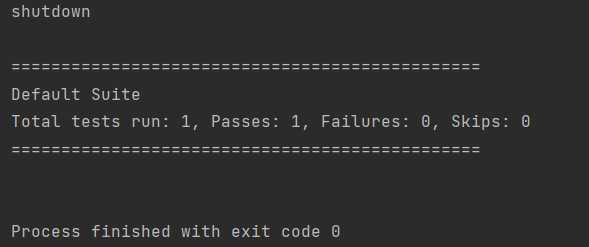
//3.读取文件
1 @Test 2 public void fileIn3(){ 3 String filePath = "D:\\testfile.txt"; 4 int readData; 5 int readlength = 0; 6 //字节数组 7 byte[] buf = new byte[8]; 8 9 FileInputStream fileInputStream = null; 10 try{ 11 //创建FileInputStream对象,用于读取文件 12 fileInputStream = new FileInputStream(filePath); 13 14 while ((readlength = fileInputStream.read(buf)) != -1){ 15 System.out.println(new String(buf,0,readlength)); 16 }; 17 18 }catch (IOException e){ 19 e.printStackTrace(); 20 }finally { 21 22 //关闭文件流 23 try { 24 fileInputStream.close(); 25 } catch (IOException e) { 26 throw new RuntimeException(e); 27 } 28 29 } 30 31 }
运行结果:
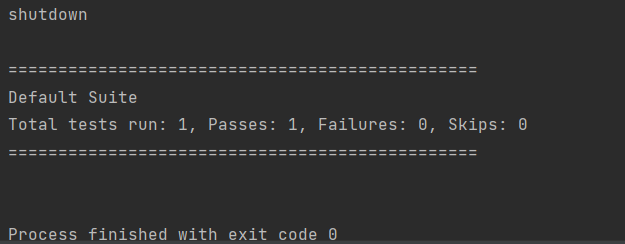
7、OutputStream
1、FileOutputStream
例子:使用FileOutputStream在文件夹中写入“hello world”,如果文件不存在,会创建文件
import org.testng.annotations.Test;
import java.io.FileNotFoundException;
import java.io.FileOutputStream;
import java.io.IOException;
public class outputStream {
public static void main(String[] args) {
}
//使用FileOutputStream将数据写到文件中
//如果文件不存在,则创建文件
1 @Test 2 public void writeFile(){ 3 String filePath = "d:\\fileout.txt"; 4 5 //创建对象 6 FileOutputStream fileOutputStream = null; 7 8 try { 9 fileOutputStream = new FileOutputStream(filePath); 10 //1、写入一个字节 11 //fileOutputStream.write('H'); 12 //2、写入一个字符串 13 //String str = "hello socket"; 14 //str.getBytes()将字符串转换成字节数组 15 //fileOutputStream.write(str.getBytes()); 16 17 //3、写入字符串 18 String str = "hello lst"; 19 fileOutputStream.write(str.getBytes(),0,str.length()); 20 21 } catch (IOException e) { 22 e.printStackTrace(); 23 }finally { 24 try { 25 fileOutputStream.close(); 26 } catch (IOException e) { 27 throw new RuntimeException(e); 28 29 } 30 31 } 32 33 }
运行结果:
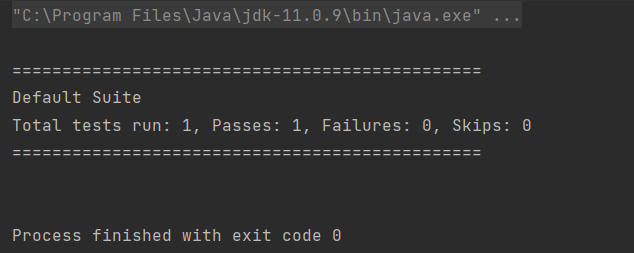
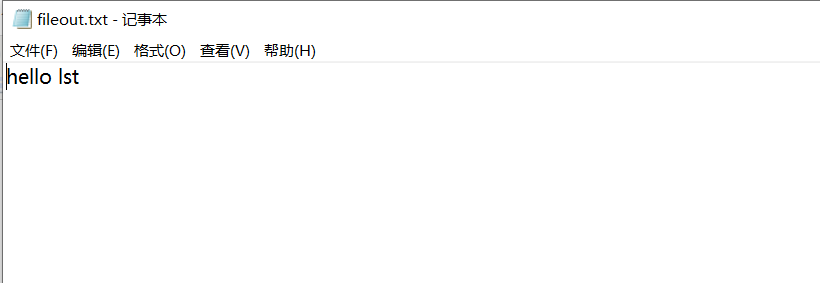
8、文件复制
1 package com.itcast.demo1; 2 import java.io.File; 3 import java.io.FileInputStream; 4 import java.io.FileOutputStream; 5 6 public class Test9 { 7 //file读和写实现复制文件 8 public static void main(String[] args) throws Exception { 9 //创建file对象 10 File f=new File("d:\\test.txt"); 11 //判断文件是否存在 12 if(f.exists()){ 13 System.out.println("test.txt存在,可以复制"); 14 }else{ 15 f.createNewFile(); 16 System.out.println("test.txt不存在,新建成功,可以复制"); 17 } 18 19 //创建FileInputStream对象 20 FileInputStream inp=new FileInputStream(f); 21 //判断demo目录是否存在 22 File f1=new File("d:\\demo"); 23 if(f1.isDirectory()){ 24 FileOutputStream out=new FileOutputStream("e:\\demo\\"+f.getName()); 25 byte bytes[]=new byte[1024]; 26 int temp=0; //边读边写 27 while((temp=inp.read(bytes))!=-1){ //读 28 out.write(bytes,0,temp); //写 29 } 30 //结束 31 inp.close(); 32 out.close(); 33 System.out.println("文件拷贝成功!"); 34 }else{ 35 //新建demo目录 36 f1.mkdir(); 37 System.out.println("demo目录不存在,已经新建成功,继续复制"); 38 FileOutputStream out=new FileOutputStream("d:\\demo\\"+f.getName()); 39 byte bytes[]=new byte[1024]; 40 int temp=0; //边读边写 41 while((temp=inp.read(bytes))!=-1){ //读 42 out.write(bytes,0,temp); //写 43 } 44 //结束 45 inp.close(); 46 out.close(); 47 System.out.println("文件拷贝成功!"); 48 } 49 50 } 51 52 }
运行结果:

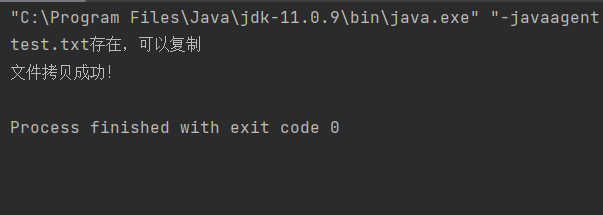
原文地址:http://www.cnblogs.com/royol/p/16859193.html
